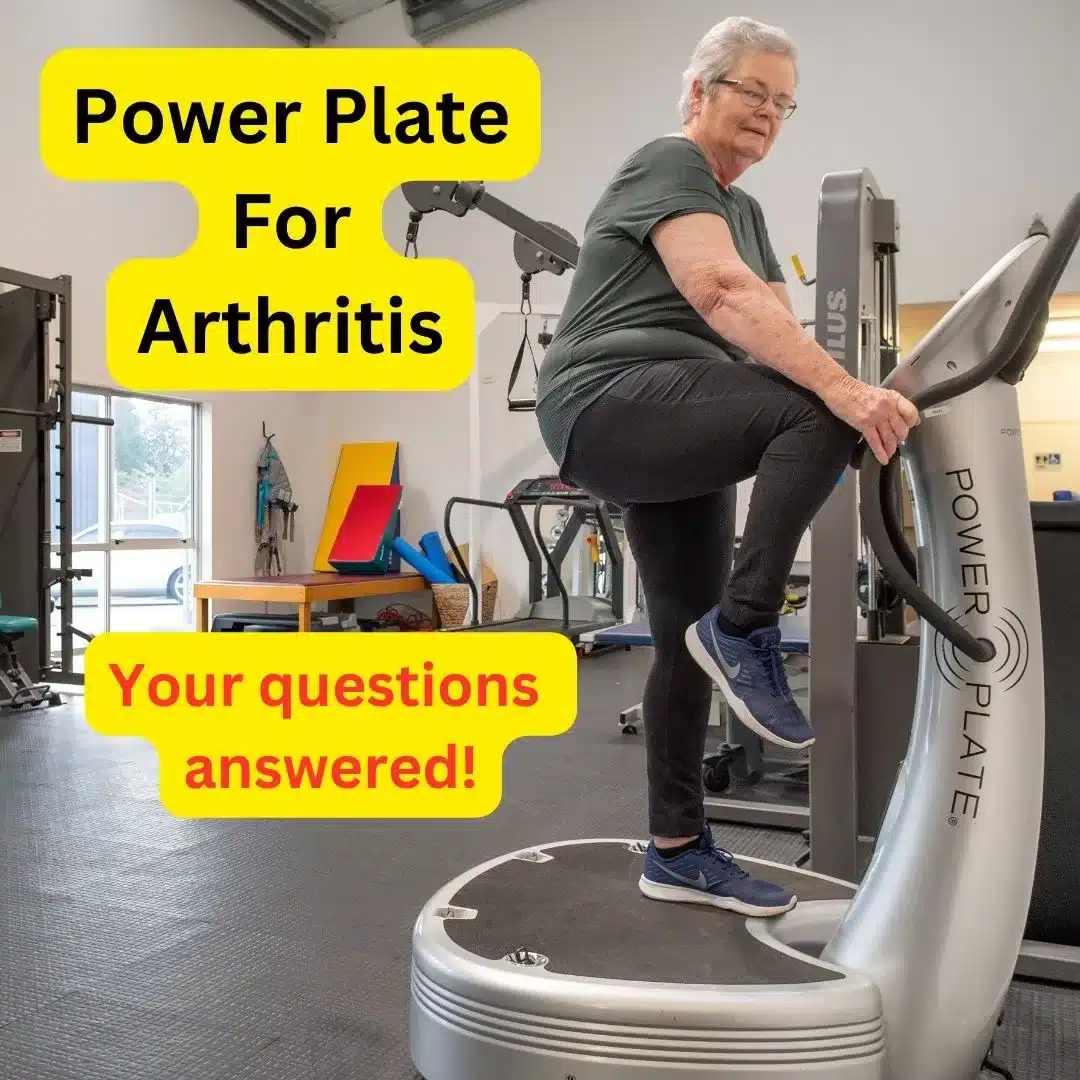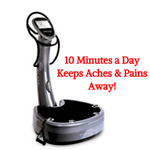Using Power Plate for Arthritis?
We aim to answer that question and you may be startled at the results.
Are you or someone you know suffering from arthritis?
If so, you are well aware of the pain and stiffness that can come with this condition.
Finding ways to manage arthritis symptoms can be a constant challenge, but there may be a new tool that can help – the Power Plate.
Arthritis, a common condition affecting millions worldwide, brings about joint pain, stiffness, and reduced mobility.
Individuals with arthritis often seek alternative therapies beyond medication to manage their symptoms effectively.
One such option gaining attention is Power Plate therapy.
But the question remains: Is Power Plate good for arthritis?
Let’s delve into the topic to understand its potential benefits and considerations for arthritis sufferers.
Understanding Arthritis:
Before exploring Power Plate therapy, it’s crucial to understand arthritis.
Arthritis encompasses various inflammatory conditions affecting the joints, including osteoarthritis and rheumatoid arthritis.
These conditions cause pain, swelling, and stiffness, impacting an individual’s quality of life and daily activities.
What is Power Plate For Arthritis Therapy?
Power Plate for arthritis therapy involves using a vibrating platform to perform exercises, stretches, and massage techniques.
The vibrations stimulate muscle contractions and increase blood flow, offering potential benefits for strength, flexibility, and circulation.
Benefits of Power Plate for Arthritis:
- Improved Joint Mobility: Power Plate exercises may help increase joint flexibility and range of motion, reducing stiffness associated with arthritis.
- Enhanced Muscle Strength: The vibrational movements engage muscles throughout the body, potentially aiding in muscle strengthening, which can support joint stability.
- Increased Circulation: The vibrations promote blood flow, delivering oxygen and nutrients to the joints and surrounding tissues, which may help alleviate pain and inflammation.
- Reduced Pain Perception: Some individuals report a decrease in pain perception after using Power Plate therapy, offering temporary relief from arthritis symptoms.
Power Plate For Arthritis Considerations and Risks
- Consultation: Before starting Power Plate therapy, individuals with arthritis should consult with their healthcare provider to ensure it’s safe and appropriate for their condition.
- Individual Variation: Responses to Power Plate therapy may vary among arthritis patients. Some may experience relief, while others may not find it beneficial or may even experience increased discomfort.
- Risk of Overuse: Excessive or improper use of Power Plate therapy may exacerbate arthritis symptoms or lead to muscle strain or injury. It’s essential to start with gentle exercises and gradually increase intensity under professional guidance.
- Cost and Accessibility: Power Plate machines can be costly, and access may be limited to gyms, rehabilitation centers, or healthcare facilities.
Use Cases for Power Plate
Strengthening exercises play a pivotal role in enhancing overall physical fitness and well-being.
These exercises target specific muscle groups, helping to build strength, endurance, and stability.
Whether using bodyweight movements, resistance bands, free weights, or specialized equipment like Power Plate machines, incorporating strengthening exercises into a fitness regimen can yield numerous benefits.
From improving posture and balance to reducing the risk of injury, the effects of regular strength training extend far beyond just muscle development.
Additionally, strengthening exercises are essential for individuals recovering from injuries or managing chronic conditions, as they help restore functionality and improve overall quality of life.
With proper guidance and progression, integrating strengthening exercises into a balanced workout routine can lead to lasting improvements in strength, mobility, and vitality.
What if I have Rheumatoid Arthritis?
Let’s talk benefits of vibration therapy for arthritis.
Rheumatoid arthritis physical therapy plays a crucial role in managing the symptoms and improving the quality of life for individuals living with this chronic autoimmune condition.
Tailored to address the specific needs and limitations of each patient, this specific therapy focuses on relieving pain, reducing inflammation, and restoring function and mobility to affected joints.
Through a combination of exercises, stretches, manual therapy techniques, and modalities such as heat and cold therapy, physical therapists aim to strengthen muscles surrounding the joints, improve flexibility, and enhance overall joint stability.
Additionally, education about joint protection techniques and ergonomic principles to help individuals better manage their condition in daily activities.
With a comprehensive and personalized approach, physical therapy empowers individuals with rheumatoid arthritis to take an active role in their treatment, promoting independence, resilience, and improved quality of life despite the challenges posed by this chronic disease.
Do Vibration plates help with Inflammation?
Vibration plates have garnered attention for their potential to alleviate inflammation, although the evidence supporting their effectiveness remains mixed.
Some studies suggest that the mechanical vibrations generated by these plates may stimulate circulation and lymphatic drainage, which could help reduce inflammation in certain conditions.
Additionally, vibration therapy may activate muscle contractions, promoting blood flow and nutrient delivery to tissues, potentially aiding in the body’s natural healing processes.
However, the extent to which vibration plates directly target inflammation remains uncertain, and their efficacy may vary depending on factors such as frequency, duration, and intensity of vibration exposure.
While some individuals report relief from inflammatory symptoms with vibration therapy, more research is needed to better understand its mechanisms and establish its role in inflammation management.
As always, consulting with a healthcare professional is recommended to determine the appropriateness of vibration plate therapy for addressing inflammation in individual cases.
Who Should Not Use Power Plate?
While Power Plate machines offer numerous benefits for many individuals, certain groups should avoid or use caution when using them.
Pregnant women, especially those in their first trimester, should refrain from using Power Plate machines due to potential risks to the fetus.
Individuals with certain medical conditions, such as epilepsy, heart conditions, or implanted medical devices like pacemakers, should also avoid Power Plate use unless approved by a healthcare professional.
People with acute injuries, fractures, or recent surgeries should wait until they have fully recovered before using Power Plate machines to prevent exacerbating their condition or causing further harm.
Additionally, those with severe balance or coordination issues may find it challenging to safely use Power Plate equipment without proper supervision.
It’s crucial for individuals with any underlying health concerns to consult with a healthcare provider before starting a Power Plate regimen to ensure its safety and suitability for their specific needs.
Power Plate For Arthritis Bottom Line
In conclusion, exploring the potential of Power Plate for arthritis reveals promising avenues for managing symptoms and improving the overall quality of life for individuals with this chronic condition.
The vibrational therapy offered by Power Plate machines presents an innovative approach to addressing joint pain, stiffness, and reduced mobility associated with arthritis.
While further research is needed to fully understand the efficacy and mechanisms of Power Plate therapy for arthritis, early evidence suggests that it may offer valuable benefits, including improved joint mobility, muscle strength, circulation, and pain relief.
As interest in alternative arthritis therapies grows, Power Plate for arthritis emerges as a promising modality that warrants consideration and exploration in conjunction with existing treatment approaches.
With continued investigation and guidance from healthcare professionals, Power Plate for arthritis holds the potential to enhance the well-being and mobility of arthritis sufferers, offering hope for a more active and fulfilling lifestyle.
Related Questions
Does a vibration plate help with inflammation?
Reduced pain and inflammation:
Studies suggest that whole-body vibration (WBV) therapy, the technology used in vibration plates, can help reduce pain and inflammation associated with conditions like osteoarthritis.
This may be due to effects like:
Improved blood circulation:
Increased blood flow can promote the removal of inflammatory substances and deliver nutrients to aid healing.
Muscle stimulation:
Vibration might trigger the release of anti-inflammatory mediators within muscles.
Pain relief:
WBV may also help manage pain through mechanisms like gate control theory, where stimulating certain nerves can “block” pain signals reaching the brain.
Who should not use Power Plate?
Pregnant women, especially those in their first trimester, should refrain from using Power Plate due to potential risks to the fetus.
Individuals with certain medical conditions such as epilepsy, heart conditions, or implanted medical devices like pacemakers should also avoid using Power Plate unless approved by their healthcare provider.
Additionally, individuals with acute injuries, fractures, or recent surgeries should wait until they have fully recovered before using Power Plate to prevent exacerbating their condition or causing further harm.
Does vibration massage help inflammation?
Vibration massage has shown promising potential in helping to alleviate inflammation, although its effectiveness can vary depending on the specific circumstances and conditions.
The mechanical vibrations generated during a vibration massage can stimulate blood flow and lymphatic drainage, which may help reduce inflammation by facilitating the removal of inflammatory substances and promoting tissue healing.
Additionally, vibration massage may help relax muscles and alleviate tension, which can contribute to inflammation and pain relief.
However, while some studies suggest that vibration massage may be beneficial for reducing inflammation in certain contexts, more research is needed to fully understand its mechanisms and effectiveness for various inflammatory conditions.
As always, consulting with a healthcare professional is recommended to determine the appropriateness of vibration massage as part of an inflammation management strategy tailored to individual needs and conditions.
Does a vibration plate help with pain?
Yes, a vibration plate can help with pain management for certain individuals and conditions.
The mechanical vibrations generated by a vibration plate can stimulate sensory receptors in the muscles and joints, which may help disrupt pain signals and provide relief.
Additionally, vibration therapy has been shown to promote the release of endorphins, which are the body’s natural pain relievers, leading to a reduction in perceived pain levels.
Furthermore, vibration therapy can improve blood circulation and lymphatic drainage, which may help reduce inflammation and alleviate pain associated with conditions such as arthritis, fibromyalgia, or muscle soreness.
However, the effectiveness of vibration plates for pain management can vary depending on the individual’s condition, the type and intensity of pain, and other factors.
Disclaimer
Some of the links on this website are affiliate links, meaning that we may earn a commission if you click on the link and make a purchase.
This helps support the creation of free content on this website.
However, our primary goal is to provide you with valuable information and recommendations, regardless of any affiliate relationship.
My opinions and recommendations are based on my honest assessment of the product or service in question.


